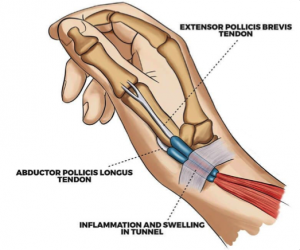
Gamer’s love gaming. That total immersion in a fantasy world where you are able to perform feats that you could never imagine in real life. Did you know that too much time gaming can have real life consequences?
Are you currently experiencing a constant achy pain around and below your thumb? Does it hurt when you grip or move it? Have you recently had a long 6-hour gaming session? You might have the “Gamer’s Thumb” also known as De Quervain’s tenosynovitis.
Gamer’s thumb is also known as De Quervain’s tenosynovitis. It is inflammation of the tendons located at the base of your thumb. The tendons commonly involved are the extensor pollicus brevis and abductor pollicus longus which is wrapped by a fibrous white sheath as you can see from the pictures below. This band holds the tendons together and causes them to rub against each other and become irritated when the sheath becomes thickened or inflamed.

Extensor pollicus brevis and abductor pollicus longus are muscles that attach to the bones of the thumb, but the muscle belly is in the forearm.
Repetitive use and movements with the thumb and wrist such as holding a gaming controller with repetitive movement of the joy stick or typing.
No – thankfully, or you would never be able to convince your mum to let you play. Other things that can cause De Quervain’s tenosynovitis include:
There are a number of signs that you might be developing Gamer’s thumb:
Overuse of the thumb is one of the biggest contributors to this condition.
Physiotherapists are experts in managing tendon injuries. To support you to recover from Gamer’s Thumb your physiotherapist will:
Our team are available to help whenever you need. You can even book online.